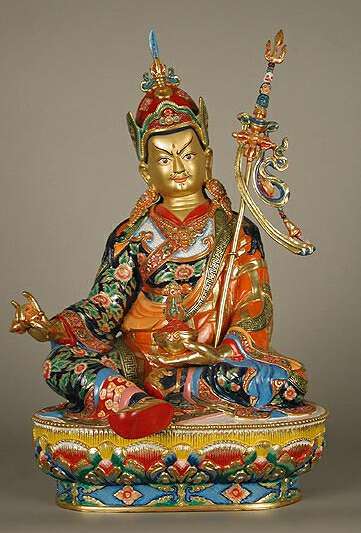Nyingmapa in Tibetan Buddhism
Guru Padmasambhava
 A magician originating in Hindhukush Padma-sambava introduced deeper the tantric doctrines of Mahayana. On this occasion, the problem was of implementing the occult forces (or magic existing rituals) to ensure the deliverance and to avoid the infinite succession of rebirths. One could use the methods of the shamanism, but with new objectives. Padma-sambava succeeded in modifying the Tibetan faith after having triumphed over all the magicians Bon-Po, whom he defeated one after the other. Under his impulse, the large temple of Samye was built in 12 years (towards 775) taking as model an Indian temple (perhaps that of Nalanda). He erected many temples between Lhasa and the valley of Yarlung, moreover, he left his foot prints everywhere in Tibet and hundreds of meditating caves within the country is believed to be blessed by his attendance, those hermitages and caves are still can be visited and functioning by local Yogis and meditators.
A magician originating in Hindhukush Padma-sambava introduced deeper the tantric doctrines of Mahayana. On this occasion, the problem was of implementing the occult forces (or magic existing rituals) to ensure the deliverance and to avoid the infinite succession of rebirths. One could use the methods of the shamanism, but with new objectives. Padma-sambava succeeded in modifying the Tibetan faith after having triumphed over all the magicians Bon-Po, whom he defeated one after the other. Under his impulse, the large temple of Samye was built in 12 years (towards 775) taking as model an Indian temple (perhaps that of Nalanda). He erected many temples between Lhasa and the valley of Yarlung, moreover, he left his foot prints everywhere in Tibet and hundreds of meditating caves within the country is believed to be blessed by his attendance, those hermitages and caves are still can be visited and functioning by local Yogis and meditators.
Buddhism almost disappeared after 842 when King Lang Darma violently persecuted Buddhism. After this, for a long time there were no ordinations and no central religious authority in Tibet. Instead, the original Bon religion prevailed.
In 978, with the introduction of several Indian Pandits and Tibetan monks studying in India, Buddhism revived, with the help of king Yeshe O from Guge Kingdom. A real revival occurred after 1042, when Atisha-di-Pankhara (or Jo Je Palden Atisha) put Tibetans “back on the right track”.
He presented the Buddhist philosophy in a very clear and condensed manner, which became the basis for philosophical teachings in most Tibetan traditions. After Atisha, the influence from Indian teachers was limited. Atisha’s main disciple was the layman Dromtönpa, who founded the Kadam-tradition. This tradition does not exist in that form anymore, but it strongly influenced the later schools of Kargyu, Sakya and especially Gelug.
Tibetan teachers like His Holiness the Dalai Lama insist that Tibetan Buddhism these days still carefully reflects the Buddhism as was present in India around the 11th century. He also rejects the term Lamaism, as it suggests as if the Tibetan teachers have developed their own form of Buddhism.
Initially, the study of logic and philosophy was limited, but much emphasis was put on tantric practice. It must be noted however, that also within the Nyingma school considerable reformation has taken place over the ages.
Some typical aspects for the Nyingma tradition: the practice of Dzogchen (seeking to examine the fundamental nature of mind directly, without relying on visualizations and images) and the presence of hidden scriptures or “terma” from Padmasambhava, which are discovered by later Masters.
In the present day head of the Nyingmapa sect is Mingdrolling Trichen Gyurme Kunsang Wangyal, unfortunately he was passed in 2008 in India. And then the throne holder of Payul lineage Kyabjé Drubwang Pema Norbu Rinpoche or Penor Rinpoche, He was widely renowned in the Tibetan Buddhist world as a master of Dzogchen, he also passed in 2009. Now the Lama Achuk (H.H Jamyang Lungdok Gyaltsen) Rinpoche from Yachen monastery of Ganzi prefecture and Dordrak Rinzin Choephle from Dorje Drak monastery in the southern Tibet are two prominent figures of the sect.
